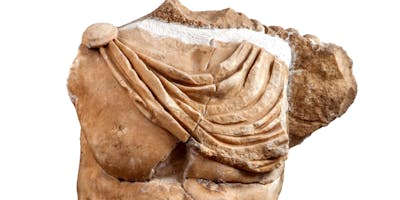You must login before you can post a comment.
Tuesday 19 November 19:00 - 21:30
Great Hall, King's College London, Strand Campus
Strand
London
WC2R 2LS
Registration
- 🍔
- 🍻
Greek Archaeological Committee UK (GACUK) Lecture by Lydia Palaiokrassa-Kopitsa (University of Athens): Ancient Andros: A History of Fourteen Centuries
Uncategorized
Speaker: Lydia Palaiokrassa-Kopitsa, Professor Emerita of Classical Archaeology at the National and Kapodistrian University of Athens, and Director of the Excavation at Palaiopolis, Andros, Greece
Andros, the homonymous ancient capital of the island for almost fourteen centuries, spread over a large area of the slope, from the seashore up to the acropolis hill, where the present village of Palaeopolis is located.
The systematic excavations of the University of Athens, which commenced in 1987, have given material culture remains that resynthesize the history and the economy of the island’s capital, and witness to diverse aspects of the everyday life of its inhabitants, public and private. They offer us knowledge on the system of governance of the city, on the factors of its affluence, the commercial networks of its sailors and traders, the way of life of the Andrians, their occupations, their houses, the sources of their income, their dietary habits, their relationship with the natural environment, their religious beliefs and practices, the gods they worshipped and their temples, their cemeteries.
The finds bespeak an extensive and flourishing city, which had control of the island well into Early Christian times. Building activity is attested from the late 6th c. BC, but sporadic moveable finds are dated as early as the Final Neolithic period and the Early and Late Bronze Age. Pottery of Geometric times, though scanty, points to the existence of a community that participated in the trading networks of the period already in the ninth century BC. The polis was founded around 700 BC, when the pre-existing settlement seems to have been organized after the synoecism of the inhabitants of the island’s Geometric settlements.
The city’s layout was articulated in zones. Its centre, the agora, was on the flat area beside the seashore in direct proximity to the harbour. Higher up on the slope was an area with important buildings and sanctuaries. Further west spread one residential area. A fourth zone was located in the direction of the acropolis. The steep gradient of the ground necessitated the construction of terraces, creating areas for cultivation, pasturage and building.
The excavations in the agora of ancient Andros have uncovered parts of public buildings and paved streets on two terraces, dating from the 5th c. BC until about the middle of the 7th c. AD. The archaeological data testify to the existence of a bouleuterion, a macellum (food market), a fish-market, a metallurgical installation, of temples and cults of deities and Roman emperors, as well as of the presence of statues of eminent citizens. Thus, the functions of the agora of Andros served political-administrative, commercial and cultic needs. The construction of three buildings in Early Christian times, two of which were churches, confirms that the agora continued to be the centre of the city.
The abandonment of the city in the middle years of the 7th c. AD was brought about by the raids of the Arabs, when the inhabitants sought refuge in the safety of the island’s hinterland.
About the speaker: Lydia Palaiokrassa-Kopitsa is Professor Emerita of Classical Archaeology at the National and Kapodistrian University of Athens, where she had been teaching since 1983. Since 1987 she is the Director of the Excavation at Palaiopolis, Andros, Greece. She is also principal investigator of “The Parnes Sanctuary of Zeus Research” Program (National and Kapodistrian University of Athens). Her publications include Τo ιερό της Αρτέμιδος Μουνιχίας (1991); Παλαιόπολις Άνδρου. Ta Οικοδομικά, Από την προανασκαφική έρευνα (1996) and the edited volumes Παλαιόπολη Άνδρου. Είκοσι χρόνια ανασκαφικής έρευνας (2007); Palaiopolis Andros. Thirty Years of Excavation Research (2018). She has also published on the Roman theater at Dion Pieria, the Gymnasium in the Sanctuary of Asclepius at Epidaurus, the Artemis Mounichia Sanctuary at Piraeus, the Zeus Sanctuary on mount Parnes, Attica, the Palaiopolis Andros excavation, the University of Athens excavation at the Makriyanni site, Athens, as well as on aspects of Greek vase-painting, iconography, sculpture, topography and religion.
This lecture is open to all, and followed by a drinks reception. Although attendance is complimentary, places are limited and pre-registration is essential
For information about campus accessibility, please see the AccessAble guide to King's College Strand Campus.
Image: Male statue from the agora of ancient Andros, Andros Archaeological Museum (I. Miari)




